
Do you have a question about the NEC M310 and is the answer not in the manual?
| Model | M310 |
|---|---|
| Category | Disk array system |
| Maximum Capacity | 96 TB |
| Host Interface | Fibre Channel, iSCSI |
| RAID Levels | 0, 1, 5, 6, 10 |
| Cache Memory | 4 GB |
| Form Factor | 2U |
| Supported Drives | SAS HDD, SSD |
Overview of M110 Disk Array (2.5") and its structure.
Overview of M110 Disk Array (3.5") and its structure.
Steps for component selection when purchasing a new system and for expansion.
System requirements and recommended product choices for M110.
Details on M110 Disk Array Base Units and Host Port Cards.
Detailed specifications for various M110 Host Port Cards.
Information on SFP modules for FC, iSCSI(Optical), and Combo interfaces.
Available SFP module combinations for dual controller FC 4Port.
Available SFP module combinations for single controller FC 4Port.
SFP combinations for dual and single controller 10Gb iSCSI Optical 4Port.
SFP combinations for dual and single controller FC/10Gb iSCSI Optical.
SFP combinations for dual and single controller FC/10Gb iSCSI Copper.
Description of Host I/F options and comparison of Dual vs. Single Controllers.
Functions available with NEC Storage Manager Suite for M110.
Guidance on selecting disk drives and disk capacity considerations.
Information on the expected lifetime of SAS HDD, NL-SAS HDD, and SAS SSD.
Table listing various disk drive models, types, and capacities.
Rules for drive usage, supported RAID types, and dynamic pool functionality.
Recommendations and rules for assigning hot spare disks.
Information on available disk enclosures, max drives, power, and accessories.
Caution regarding the maximum number of disk enclosures supported.
Table showing sums of disk drive slots for various configurations.
Diagrams and explanations for connecting disk enclosures (DE) to the unit.
Information on dummy HDDs, front bezels, and management LAN port support.
Structure and overview of the M310 Disk Array for 2.5" drives.
Structure and overview of the M310 Disk Array for 3.5" drives.
Steps for selecting components when purchasing or expanding M310.
System requirements and recommended product choices for M310 Host I/F.
Details on M310 Disk Array Base Units and Host Port Cards.
Information on SFP modules for FC, iSCSI(Optical), and Combo interfaces.
Available SFP module combinations for dual controller FC 4Port.
SFP combinations for dual controller 10Gb iSCSI Optical 4Port.
SFP combinations for dual controller FC/10Gb iSCSI Copper.
Functions available with NEC Storage Manager for M310.
Guidance on selecting disk drives based on type, capacity, and RAID requirements.
Information on the expected lifetime of SAS HDD, NL-SAS HDD, and SAS SSD.
Table listing various disk drive models, types, and capacities.
Rules for drive usage, supported RAID types, and dynamic pool functionality.
Recommendations and rules for assigning hot spare disks.
Information on available disk enclosures, max drives, power, and accessories.
Caution regarding the maximum number of disk enclosures supported.
Diagrams for connecting disk enclosures (DE) to the unit.
Details on cache memory models and capacity expansion for M310.
Standardized height (U) and depth of M-Series Disk Array units.
Guidelines for mounting disk array units in a rack, including weight and spacing.
Overview of disk drive form factors, speeds, and types (SSD, SAS, NL-SAS).
Detailed descriptions of SSD, SAS HDD, and NL-SAS HDD types.
Usage scenarios for NL-SAS HDD, SAS HDD, and SSD.
Example illustration of mixing SAS and NL-SAS drives.
Definition of a pool as a virtual storage area configured from physical disks.
Description of Basic Pools and Dynamic Pools, focusing on Dynamic Pools.
Recommendations for pool configuration and minimum/maximum disk drives.
Procedure for expanding pool capacity by adding disks, including time dependency.
Table detailing logical disk parameters for M110 and M310.
Procedure for expanding logical disk capacity online, depending on the OS.
Importance and benefits of hot spare disks for data redundancy.
Priority rules for selecting hot spare disks with different types.
Explanation of Copy Back Mode (Off and On) for hot spare disk operations.
Recommended numbers of hot spare disks for different drive types.
How the function backs up system data for replication.
Comparison of scenarios with and without a replication reserved volume.
Details on SED (Self Encryption Drive) types and their advantages.
List of M-Series supported SED models with specifications.
Steps for setting up encryption using NEC StorageManager.
Important notes regarding mixing SEDs, replication, snapshots, and caching.
Explanation of MAID technology for reducing power consumption.
Diagram illustrating power states for M110 with MAID technology.
Methods for controlling unused disks and spare disks for power saving.
Benefits of server virtualization for utilizing resources.
How VAAI (vStorage API for Array Integration) optimizes storage performance.
How VAAI support settings are configured via NEC StorageManager.
Comparison of Full Copy with and without VAAI enabled.
Comparison of Block Zeroing with and without VAAI enabled.
Comparison of locking mechanisms with and without hardware assistance.
How VAAI enables space reclamation for thin provisioning.
Maximum capacities for replication volume (RV) and dynamic pool.
Support matrix for in-box and inter-box replication by interface and controller.
Maximum capacities and generations for snapshot volumes.
Support matrix for snapshot functionality by interface and controller.
Role of cache memory and replication reserved volume in differential management.
Guidelines for selecting UPS units based on power requirements.
How redundant power supplies operate and handle failures.
Specific configuration elements for standby UPS units.
Configuration for e-mail notification from storage unit with embedded ISM.
Configuration for e-mail notification via an external iSM Server.
How PerforCache uses SSDs to improve response and reduce costs.
Detailed uses of second cache for read, write, and persistent write.
Requirements for arranging PerforCache and the minimum SSDs needed.
Considerations for installing PerforCache on existing or new arrays.
Wear/lifetime specifications for components like Disk Array Unit, HDD, SAS SSD, and Battery.
Guidelines and factors affecting battery life and replacement.
Recommendations for regular replacement of mechanical parts like drives and fans.
